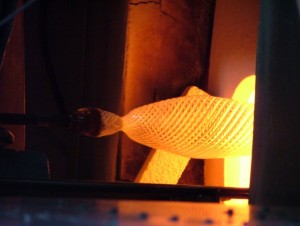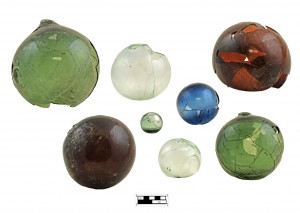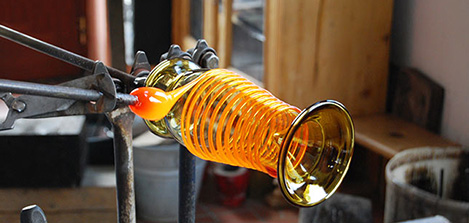
Glass is an extremely versatile material that is commonly used for various types of vessels, windows, and optics. We see it everywhere, but it is not easily defined. Glass is neither a true liquid nor a solid, but shares the qualities of both. It is often called an amorphous solid, and some scientists even consider it a fourth state of matter.
Making Glass
Glass is made by heating a mixture of dry ingredients, called batch, to a viscous state, then cooling it fast enough to prevent a regular crystalline structure. As the glass cools and becomes hard like a solid, the atoms become locked in a disordered state, like a liquid.
Glass batch has three main ingredients:
- Silica (silicon dioxide) found in sand, is the main component in glass. It requires very high heat to become viscous.
- An alkaline flux is needed to lower the melting point of the silica. In historical glass, the flux is usually soda ash (sodium carbonate), derived from marine plant ashes, or potash (potassium carbonate), made by burning bracken and trees.
- A stabilizer is needed because the first two ingredients are water soluble. Lime (calcium carbonate) is the most common stabilizer. Lead may also be used.
Batch is heated in a furnace to about 2400˚F. Broken glass, called cullet, is added to the batch to facilitate the melting process. Sometimes the glass itself is referred to as the “metal.” Other additives in the batch can change the properties and appearance of the glass, for example making it stronger, less reactive to heat, or opaque. There are thousands of different glass recipes.
http://www.youtube.com/watch?v=Q5NJ8jZ8M0k
This video was made at The Studio of The Corning Museum of Glass and shows how glass is made today. The batch was purchased premixed and heated in a computer-regulated furnace fueled by natural gas. Prior to these 20th-century advantages, glass factories acquired the raw materials and mixed the batch themselves. Factories in early America used wood for fuel before switching to coal. Variations in the quality of the glass itself and the accidental gray, tan, or pink tint often seen in “colorless” glass, are evidence of the challenges glassmakers faced.
http://www.youtube.com/watch?v=SWQzREycTyA
Coloring Glass

The color of glass is determined by metallic oxides in the batch. Naturally occurring iron in the sand causes various shades of green, amber, and brown. Decolorants, such as manganese dioxide, are used to take the natural color out of glass. However, it is very difficult to get all of the iron out of the sand. Common glass that appears colorless (clear) still has a subtle green or aquamarine tint visible in cross-section or in the thickest areas. “Artificial” colorants include cobalt for blue, manganese for amethyst, uranium for bright yellow and yellow green, tin for opaque white, and gold chloride for ruby red.
http://www.youtube.com/watch?v=M9e9_jcC-Ls
All of the illustrated artifacts were recovered from the I-95/Girard Avenue Project area in Philadelphia. Videos presented courtesy of The Corning Museum of Glass.
